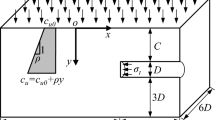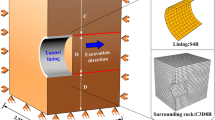Abstract
This study investigates the critical support pressure at collapse on the tunnel face at different cover-to-diameter (\({C \mathord{\left/ {\vphantom {C D}} \right. \kern-0pt} D}\)) ratios. During shallow tunnelling, the cover-to-diameter ratios may change from a positive to a negative value. The collapse of tunnel face was modelled with the use of finite element analyse (FEA) with consideration of different soil strength parameters, cover-to-diameter ratios and support pressure distribution patterns. The numerical simulations were verified against published experimental data for different \({C \mathord{\left/ {\vphantom {C D}} \right. \kern-0pt} D}\) ratios, and the results agree well with each other. A design chart for determining the critical support pressure at collapse under undrained conditions is developed based on the FEA results. The effectiveness of the design chart in conjunction with volume loss predicted by Klar and Klein’s equation to predict volume loss at collapse failure for tunnelling in soft soils is demonstrated through two case histories.














Similar content being viewed by others
References
Anagnostou G (2012) The contribution of horizontal arching to tunnel face stability. Geotechnik 35:34–44
Anagnostou G, Kovari K (1994) The face stability of slurry-shield-driven tunnels. Tunn Undergr Space Technol 9(2):165–174
Anagnostou G, Kovari K (1996) Face stability conditions with earth-pressure-balanced shields. Tunn Undergr Space Technol 11:165–173
Belter B, Heiermann W, Katzenbach R, Maidl B, Quick H, Wittke W (1999) NBS Köln-Rhein/Main-Neue Wege bei der Umsetzung von Verkehrsprojekten. Bauingenieur 74:1–7
Broere W (2001) Tunnel face stability and new CPT applications. Ph.D. thesis, Delft University of Technology, The Netherlands
Broms BB, Bennermark H (1967) Stability of clay at vertical opening. J Soil Mech Found Div 93(1):71–94
Cairncross AM (1973) Deformations around model tunnels in stiff clay. Ph.D. thesis, University of Cambridge
Casarin C, Mair R (1981) The assessment of tunnel stability in clay by model tests. In: Reséndiz D, Romo MP (eds) Soft-ground tunnelling: failures and displacements. A.A. Balkema, Rotterdam, pp 33–34
Chambon P, Corte J-F (1994) Shallow tunnels in cohesionless soil: stability of tunnel face. J Geotech Eng 120(7):1148–1165
Chen WF (1975) Limit analysis and soil plasticity. Elsevier, Amsterdam
Chen RP, Tang LJ, Ling DS, Chen YM (2011) Face stability analysis of shallow shield tunnels in dry sandy ground using the discrete element method. Comput Geotech 38(2):187–195
Chen RP, Li J, Kong LG, Lj Tang (2013) Experimental study on face instability of shield tunnel in sand. Tunn Undergr Space Technol 33:12–21
Chen RP, Tang LJ, Yin XS, Chen YM, Bian XC (2015) An improved 3D wedge-prism model for the face stability analysis of the shield tunnel in cohesionless soils. Acta Geotech 10:683–692
Coulomb C (1773) Sur une application des règles de maximis et minimis á quelques problèmes relatifs á l’architecture. Mémoire Acad R Sci 7:343–382
Dassault Systèmes Simulia Corp (2014) Abaqus user’s manual, version 6.14. Providence, R.I., USA
Davis EH, Gunn MJ, Mair RJ, Seneviratne HN (1980) The stability of shallow tunnels and underground openings in cohesive material. Geotechnique 30(4):397–416
Dimmock PS, Mair RJ (2007) Estimating volume loss for open-face tunnels in London Clay. Proc Inst Civ Eng-Geotech 160(1):13–22
Drucker DC, Prager W (1952) Soil mechanics and plastic analysis or limit design. Q Appl Math 10:157–165
Fan Z, Zhang Z (2013) Model test of excavation face stability of EPB shield in sandy cobble ground and adjacent building effect. Yanshilixue Yu Gongcheng Xuebao/Chin J Rock Mech Eng 32(12):2506–2512 (in Chinese)
Harding H (1981) Tunnelling history and my own involvement. Golder Associates, Toronto
Hayashi M, Miki K, Yokomizo F, Yoshida M, Izawa M (2006) The demonstration work of URUP method. In: Proceedings of the 61st annual conference of Japan society of civil engineers. Shiga Prefecture, pp 485–486
Horn M (1961) Horizontal earth pressure on perpendicular tunnel face. In: Hungarian national conference of the foundation engineer industry, Budapest, pp 7–16
Huang R (2008) Overview of Shanghai Yangtze River tunnel project. Geotechnical Aspects of Underground Construction in Soft Ground. CRC Press, Boca Raton
Idinger G, Aklik P, Wu W, Borja RI (2011) Centrifuge model test on the face stability of shallow tunnel. Acta Geotech 6(2):105–117
Jancsecz S, Steiner W (1994) Face support for a large mix-shield in heterogeneous ground conditions. Tunnelling ’94. Springer, pp 531–550
Kamata H, Mashimo H (2003) Centrifuge model test of tunnel face reinforcement by bolting. Tunn Undergr Space Technol 18:205–212
Kanayasu S, Kubota I, Shikibu N (1995) Stability of face during shield tunneling–a survey of Japanese shield tunneling. Undergr Construct Soft Ground pp 337–343
Karim ASMM (2007) Three-dimensional discrete element modeling of tunneling in sand. Ph.D. thesis, Canada: University of Alberta
Kirsch A (2010) Experimental investigation of the face stability of shallow tunnels in sand. Acta Geotech 5(1):43–62
Klar A, Klein B (2014) Energy-based volume loss prediction for tunnel face advancement in clays. Geotechnique 64(20):776–786
Leca E, Dormieux L (1990) Upper and lower bound solutions for the face stability of shallow circular tunnels in frictional material. Geotechnique 40(4):581–606
Leca E, Dormieux L (1992) Contribution à l’étude de la stabilité du front de taille d’un tunnel en milieu cohérent. Rev Française Géotech 61:5–16
Lee IM, Nam SW, Ahn JH (2003) Effect of seepage forces on tunnel face stability. Can Geotech J 40(2):342–350
Li S (2007) Experiment and performance analysis of shear band for cohesive soil. Ph.D. thesis, Nan**g University of Technology, Nan**g, China (in Chinese)
Li Y (2008) Stability analysis of large slurry shield-driven tunnel in soft clay. Ph.D. thesis, Tongji University, Shanghai (in Chinese)
Li Z (2015) Deformation and stability investigation of underground excavations of subway transit system in soft clay. Zhejiang University, Hangzhou (in Chinese)
Li Y, Emeriault F, Kastner R, Zhang ZX (2009) Stability analysis of large slurry shield-driven tunnel in soft clay. Tunn Undergr Space Technol 24(4):472–481
Liu C, Zhang ZX, Regueiro RA (2014) Pile and pile group response to tunnelling using a large diameter slurry shield—case study in Shanghai. Comput Geotech 59:21–43
Liu C, Zhang ZX, Kwok CY, Jiang HQ, Teng L (2017) Ground responses to tunneling in soft soil using the URUP method. J Geotech Geoenviron Eng 143(7):04017023
Lu X, Wang H, Huang M (2014) Upper bound solution for the face stability of shield tunnel below the water table. Math Probl Eng 2014:1–11
Macklin SR (1999) The prediction of volume loss due to tunnelling in overconsolidated clay based on heading geometry and stability number. Ground Eng 32(4):30–33
Mair RJ (1979) Centrifugal modelling of tunnel construction in soft clay. Ph.D. thesis, Cambridge University
Mair R (1993) Unwin memorial lecture 1992: developments in geotechnical engineering research: application to tunnels and deep excavations. Proc Inst Civ Eng Civ Eng 97(1):27–41
Mair R, Taylor R (1997) Bored tunnelling in the urban environment. In: The 14th international conference on soil mechanics and foundation engineering, Rotterdam, pp 2353–2385
Mair R, Gunn M, O’Reilly M (1981) Ground movements around shallow tunnels in soft clay. In: The 10th international conference on soil mechanics and foundation engineering: international society for soil mechanics and foundation engineering, pp 323–328
Mair RJ, Taylor RN, Bracegirdle A (1993) Subsurface settlement profiles above tunnels in clays. Geotechnique 43(2):315–320
Maynar MJM, Rodriguez L (2005) Discrete numerical model for analysis of earth pressure balance tunnel excavation. J Geotech Geoenviron 131(10):1234–1242
Mollon G, Dias D, Soubra AH (2010) Face stability analysis of circular tunnels driven by a pressurized shield. J Geotech Geoenviron 136(1):215–229
Mollon G, Dias D, Soubra AH (2013) Continuous velocity fields for collapse and blowout of a pressurized tunnel face in purely cohesive soil. Int J Numer Anal Methods 37(13):2061–2083
Nakamura T, Hazama H (2010) URUP (Ultra Rapid under Pass) method the first implementation in a public project. In: The 5th civil engineering conference in the asian region and Australasian structural engineering conference 2010, Engineers Australia, Sydney, pp 1175–1180
Peck RB (1969) Deep excavations and tunneling in soft ground. In: The 7th international conference on soil mechanics and foundation engineering: Sociedad Mexicana de Mecánica, pp 225–290
Schofield AN (1980) Cambridge geotechnical centrifuge operations. Geotechnique 30(3):227–268
Soubra AH (2000) Three-dimensional face stability analysis of shallow circular tunnels. In: ISRM international symposium. International Society for Rock Mechanics, Melbourne, Australia
Soubra AH (2002) Kinematical approach to the face stability analysis of shallow circular tunnels. In: 8th international symposium on plasticity. British Columbia, Canada
Tang X-W, Liu W, Albers B, Savidis S (2014) Upper bound analysis of tunnel face stability in layered soils. Acta Geotech 9(4):661–671
Vermeer PA, Ruse N, Marcher T (2002) Tunnel heading stability in drained ground. Felsbau 20(6):8–18
Wong KS, Ng CWW, Chen YM, Bian XC (2012) Centrifuge and numerical investigation of passive failure of tunnel face in sand. Tunn Undergr Space Technol 28:297–303
Yang Y (2011) Experimental study on engineering properties of Qiantang alluvial silts. Zhejiang University, Hangzhou (in Chinese)
Zhang ZX, Hu XY, Scott KD (2011) A discrete numerical approach for modeling face stability in slurry shield tunnelling in soft soils. Comput Geotech 38(1):94–104
Zhang C, Han K, Zhang D (2015) Face stability analysis of shallow circular tunnels in cohesive–frictional soils. Tunn Undergr Space Technol 50:345–357
Zhang ZX, Liu C, Huang X, Kwok CY, Teng L (2016) Three-dimensional finite-element analysis on ground responses during twin-tunnel construction using the URUP method. Tunn Undergr Space Technol 58:133–146
Zizka Z, Thewes M (2016) Recommendations for face support pressure calculations for shield tunnelling in soft ground. German Tunnelling Committee (ITA-AITES), Cologne, Germany
Acknowledgements
The research was conducted with funding provided by the National Science Foundation of China (Grant Nos. 41372276 & 51509186). The second author would like to acknowledge the support provided by Guangzhou University (Grant No. 2700050340). The first and second authors would like to acknowledge the support provided by Shanghai Tunnelling Engineering Co., Ltd.
Author information
Authors and Affiliations
Corresponding author
Rights and permissions
About this article
Cite this article
Zhang, Z.X., Liu, C. & Huang, X. Numerical analysis of volume loss caused by tunnel face instability in soft soils. Environ Earth Sci 76, 563 (2017). https://doi.org/10.1007/s12665-017-6893-1
Received:
Accepted:
Published:
DOI: https://doi.org/10.1007/s12665-017-6893-1




